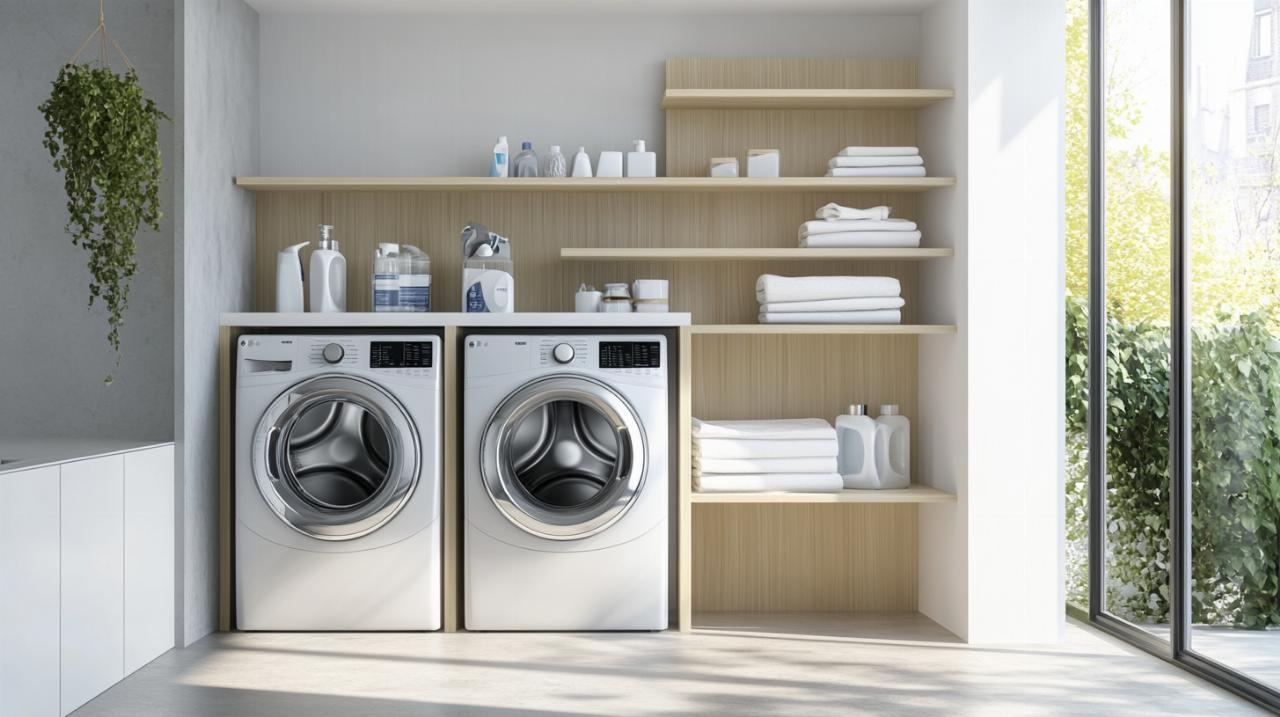Transforming a cramped laundry area into a functional space often requires some clever organisation, and stacking your appliances can be a brilliant solution. Whether you’re working with a compact utility room or a cosy kitchen corner, placing your tumble dryer atop your washing machine is a practical approach to maximising every inch. However, this task demands careful attention to detail and the right equipment to ensure both safety and efficiency. Rushing through the process or cutting corners could lead to wobbly appliances, excessive noise, or even damage to your machines. With the proper preparation and a suitable stacking kit, you can create a stable, space-saving setup that functions smoothly for years to come.
Understanding the Importance of Proper Stacking Equipment
Stacking your washing machine and tumble dryer is not simply a matter of placing one appliance on top of the other and hoping for the best. The process requires a dedicated stacking kit designed to distribute weight evenly and prevent dangerous movement during operation. These kits are far more than a simple base; they incorporate features that absorb vibrations, provide grip, and ensure the upper appliance remains securely in place. Without such a kit, the dryer could shift or even topple during a high-speed spin cycle, causing significant damage or injury. The investment in a quality stacking kit is modest compared to the potential cost of replacing damaged appliances or repairing property.
When considering stacking washer and dryer safely, the choice between a universal kit and a brand-specific option becomes crucial. Universal kits offer versatility, fitting a wide range of makes and models, while brand-specific kits are engineered to match the exact dimensions and mounting points of particular appliances. The latter option typically provides a more precise fit, reducing the risk of instability. Regardless of which type you choose, the kit must accommodate the width and depth of your machines, with most designed to suit appliances measuring between forty-seven and sixty-two centimetres in depth. Additionally, check the weight capacity, particularly if the kit includes a storage shelf, which usually supports around twelve kilograms.
Why you must never improvise with homemade solutions
The temptation to cobble together a makeshift stacking solution using spare bits from the garage or shed might seem appealing, especially if you’re trying to save a few pounds. However, this approach is fraught with risks. Homemade solutions lack the engineering and testing that go into commercially available stacking kits, meaning they may not distribute weight evenly or absorb vibrations adequately. A washing machine in full spin can generate considerable force, and without a properly designed kit, the dryer could shift, slide, or even fall. Such an incident could result in costly repairs, damage to your flooring, or worse, personal injury. Manufacturers design stacking kits with specific materials and grippy components to prevent these dangers, ensuring that both appliances remain firmly in place throughout their operation.
Moreover, improvised setups often fail to account for the unique dimensions and mounting requirements of modern appliances. Even a slight mismatch in size or stability can lead to uneven load distribution, which exacerbates vibrations and noise. High-quality kits are constructed from robust metal or durable plastic, featuring non-slip surfaces that grip both the top of the washer and the base of the dryer. These thoughtful design elements are absent in DIY solutions, which is why relying on official kits is not just recommended but essential for safe installation.
Checking compatibility between your appliance models
Before purchasing a stacking kit or attempting to assemble your appliances, verifying compatibility is a critical step. Not all washing machines and tumble dryers are designed to be stacked, and attempting to pair incompatible models can lead to instability or even void warranties. Ideally, both appliances should come from the same manufacturer, as this ensures their dimensions, mounting points, and weight distribution are harmonised. Even within a single brand, different models may have varying specifications, so consulting the instruction manuals or manufacturer’s website is essential. These resources will confirm whether your specific models are suitable for stacking and which kits are recommended.
Standard washing machines and tumble dryers typically measure around eighty-five centimetres in height, meaning a stacked configuration will reach at least one hundred and seventy centimetres. Together, they occupy approximately six-tenths of a cubic metre of floor space, though you must allow an additional fifty to eighty millimetres on each side for cords, vents, and heat dissipation. Clothes dryers themselves can weigh anywhere from forty-five to sixty kilograms depending on their size and type, so ensuring the washing machine beneath can support this load is vital. Checking compatibility is not merely about physical dimensions; it also involves confirming that the dryer’s mounting points align with those on the stacking kit and that the washer’s top surface is suitable for supporting the additional weight.
Preparing your washing machine for safe stacking
Preparation is the foundation of a successful stacking installation, and it begins with ensuring your washing machine is positioned correctly and remains stable. Before even considering placing the dryer on top, you must verify that the washer is level and firmly anchored in place. An uneven washing machine will not only cause the entire stack to wobble but can also lead to excessive vibrations, increased noise, and accelerated wear on both appliances. Use a spirit level to check the machine in multiple directions, adjusting the feet as necessary to achieve perfect balance. This step cannot be rushed or approximated; precision is essential for the safety and longevity of your setup.
Once the washing machine is level, inspect the surrounding area to ensure it provides adequate support. The floor beneath must be solid and even, capable of bearing the combined weight of both appliances, which can easily exceed one hundred and thirty kilograms when fully loaded. Soft or uneven flooring, such as loose floorboards or worn linoleum, may need reinforcement before installation. Additionally, clear the space of any obstructions and ensure there is sufficient room to manoeuvre the dryer into position. Enlisting a helper is strongly advised, as lifting and positioning a tumble dryer safely requires two people to avoid injury or damage to the appliances.
Ensuring your washer is perfectly level before stacking
Achieving a perfectly level washing machine is non-negotiable when preparing for stacking. Even a slight tilt can cause the dryer to shift during operation, increasing the risk of instability. Modern washing machines are equipped with adjustable feet, which allow you to raise or lower each corner independently. Begin by placing a spirit level on top of the washer, checking both front-to-back and side-to-side orientations. If the bubble is off-centre, adjust the feet by turning them clockwise to lower or anticlockwise to raise the machine. Repeat this process until the level indicates a perfectly horizontal surface in all directions.
Regular maintenance also plays a role in keeping the washer level. Over time, the machine’s feet may loosen or shift due to vibrations, especially if the floor beneath is not entirely stable. Periodically re-check the level and tighten the lock nuts on the feet to prevent movement. This simple step can make a significant difference in the overall stability of your stacked setup, reducing wear on both appliances and minimising the risk of accidents.

Creating Adequate Space for Hoses and Electrical Cables
Proper cable and hose management is another crucial aspect of preparing your washing machine for stacking. Both appliances require access to power, and the washing machine needs water supply and drainage hoses, while the dryer may need ventilation ducting. Cramming these connections into too small a space can cause kinks, pinches, or even damage to the hoses and cables, which can lead to leaks, electrical faults, or reduced efficiency. Allow at least fifty to eighty millimetres of clearance on each side of the appliances to accommodate these connections without forcing them into unnatural positions.
When positioning the appliances, ensure that hoses are not stretched taut or compressed, as this can restrict water flow and increase the risk of bursts. Electrical cables should be routed away from heat sources and sharp edges, and never draped across the back of the dryer where they could be pinched. If your dryer requires ventilation, ensure the duct is correctly fitted and that there is adequate airflow to prevent overheating. Proper planning of these elements not only enhances safety but also improves the efficiency of both machines, helping them operate at their best.
After securing the stacking kit according to the manufacturer’s instructions, tighten all screws and bolts firmly to prevent any movement. Lift the dryer carefully, ideally with a second person to share the load, and position it onto the stacking kit, ensuring it sits squarely and securely. Give the dryer a firm push from various angles to test stability; if it wobbles or shifts, recheck the kit installation and adjust as necessary. Once satisfied with the setup, connect all power and ventilation as required, then run a test load in both machines to ensure they operate smoothly without excessive noise or movement. Regularly inspect the fixings every few months to ensure they remain tight, and avoid overloading the machines or distributing laundry unevenly, as this can increase vibrations and stress on the stack. Keeping filters and drains clean will also help both appliances run more smoothly, prolonging their lifespan and maintaining the safety of your space-saving setup.




